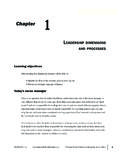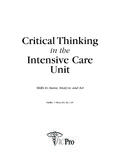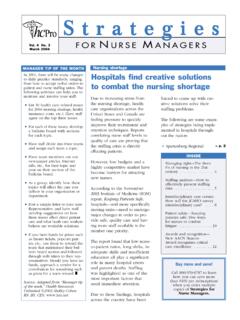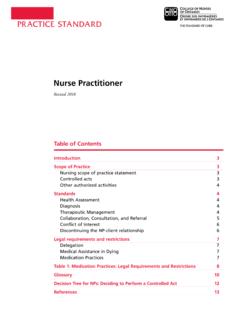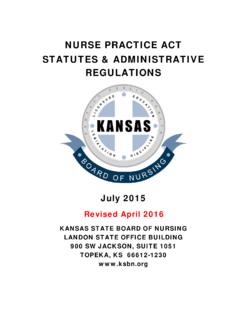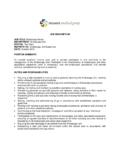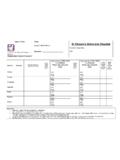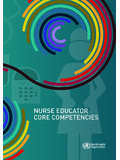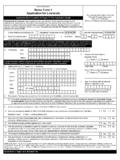Transcription of CHAPTER 1 WHAT IS A PRECEPTORSHIP - Nurse …
1 1 Nurse Preceptor Program Builder, Second Edition 2007 HCPro, IS A PRECEPTORSHIP ?LEARNING OBJECTIVES explain the need for establishing effective Nurse preceptorships in today s complex healthcareenvironments differentiate between coaching, precepting, and mentoring describe the role of preceptorships in orientationsThe capacity to watch over and guard the well-being of others is an important gift, and one that is learnedwith great difficulty. For it is one thing to see the situation others are in, but it is quite another to careenough about them to want to help, and yet another to know what to do. Judie BoppIntroductionWhy is it so important for nurses to precept others? Why do preceptees need to experience the guid-ance and facilitation shown by working nurses in clinical settings? We can find many reasons and benefits in recorded literature (see the Bibliography for more information). However, perhaps themost basic and all-encompassing reason is that it works. After reading this CHAPTER , the par ticipant will be able to CHAPTER12 Nurse Preceptor Program Builder, Second Edition 2007 HCPro, often, two peers can solve difficulties they encounter in their work together much better than withan educator or manager no matter how expert or experienced the manager may be.
2 In many ways,the working Nurse preceptor can help a new Nurse or student preceptee more than the educator or apeer. The problem or issue the preceptee wants the preceptor to explain is one that the preceptor hasrecently handled. On the other hand, more experienced staff on the unit may have encountered thesituation or question so long ago that they have forgotten much that is important to the staff see a multitude of other problems, limitations, needs, and issues that ought to concern thepreceptee, but do not. The staff also see the problem or situation in such a completely different lightthat they cannot fully understand what is really troubling the new preceptee (Benner 1984).Effective, consistent, thorough preceptorships are a major factor in the recruitment and retention ofnurses. Magnet Recognition Program hospitals support professional nursing practice within the con-text of teaching and learning environments. They provide consistently high-quality nursing care whileaccommodating excellent preceptorships.
3 Reconciling these two factors requires creativity, flexibility,and a commitment to quality nursing care through facilitated orientations, competency assessments,and competency verifications by need for effective preceptors continues to rise as companies groom and grow talent from withintheir ranks. Establishing definitive Nurse preceptorships to guide nursing students and prepare newnurses for today s demanding professional practice environments is efficient and cost-effective whendone well. Although Nurse managers are the key to Nurse recruitment, staff nurses are the key toretention. Professional Nurse preceptors demonstrate skill in communication and the ability to workcollaboratively with others, embrace servant leadership in their sense of service to others, enjoy well-established credibility, and determine the best possible patient care outcomes in all practice effective staff Nurse PRECEPTORSHIP program with such preceptors is critical to the success of studentnurses, new graduate nurses, and experienced nurses moving among the multiple disciplines and spe-cialty areas of our complex healthcare systems.
4 Key definitionsMany experts have defined and described the concepts of coach, preceptor, and mentor. Yet nursesremain confused as to how to apply these concepts in practice. The definitions presented here drawfrom multiple resources, so the terms can be standardized in training and IS A PRECEPTORSHIP ?3 Nurse Preceptor Program Builder, Second Edition 2007 HCPro, advise and instruct the Nurse primarily on job-related activities and tasks in other words,how to perform and prioritize technical tasks, documentation, Nurse and patient safety issues, organi-zational relationships and etiquette, professional work habits, and how to organize and delegate workassignments and duties. Coaches introduce new nurses or students to the healthcare team and describethe roles of each member. They make suggestions on effective patient care activities; time and stressmanagement; and how to organize, prioritize, and delegate work assignments. Coaching is generallytime-limited and reliant on proximity.
5 Coaches often orient new nurses and students and help newnurses verify their initial unit-specific competencies when they first arrive on the unit or work encourage nurses to move beyond the status quo and help them find groundbreaking profes-sional opportunities, such as exploring new leadership roles, accepting speaking or writing engagements,or acquiring advanced learning experiences. They challenge mentees and step into the background, urg-ing the new or experienced Nurse forward. Mentors allow nurses to learn through many of their ownfailures as mentees grow and develop through debate, active listening, and open communication withone another. By acting as a source of intellectual stimulation and encouragement, mentors help nursesdevelop trust in their own abilities and skills. They push them to search out professional paths thatthe Nurse might not have known about or taken much longer to discover otherwise. Mentorships can continue for an indeterminate length of time and are not reliant on into mutual or shared mentoring behaviors.
6 Some nurses have continued to mentor one anoth-er across years and continents, well beyond the initial phase of the is a period of introduction to the philosophy, mission, vision, goals, policies, procedures, roleor position expectations, physical facilities and resources, patient populations, and services of a particularpractice setting upon entry into a new position or setting or when roles/responsibilities are experienced and competent staff nurses who may have received formal training to func-tion in this capacity and who serve as role models and resource people to newly employed staff nurses,student nurses, or new graduate nurses (preceptees). They merge the knowledge, skills, abilities, andCHAPTER14 Nurse Preceptor Program Builder, Second Edition 2007 HCPro, of both coaches and mentors to help preceptees develop and mature into strong practicing pro-fessionals within new or different professional practice environments. Preceptors introduce preceptees to their new roles and responsibilities, coach them on the basics (where to park; when to report; where to find supplies and resources; how to find and use unit/area-specific equipment, unit/area rules or guidelines, and the organization s strategic plan, etc.)
7 , supportand shape critical-thinking skills, evaluate performance and give feedback for improvement, and introduce the Nurse to a wider network of nurses, frequently recommending preceptees for projects,committees, advancements, and honors within the professional practice environment and is generally time-limited and reliant on proximity. Preceptors orient new nurses and stu-dents, help them verify their initial service-specific and unit-specific competencies when they firstarrive onthe unit or work area, and provide ongoing support and encouragement as preceptees transi-tion into their new roles. Eventually, the PRECEPTORSHIP may evolve into a mentorship as the precepteematures into his or her new role and careRelationship-based care (RBC) is a nursing model for transforming practice (Koloroutis 2004), focus-ing on the value of relationships the healthcare provider s relationships with patients, families, andcommunity; with self; and with colleagues and interdisciplinary team members.
8 RBC and servantleadership ground the professional practice environment of care into one in which care providers arecentral and able to focus all their knowledge, skills, and abilities on patients and families. This is theessence of staff-centered, patient-focused, relationship-based care. Preceptorships provide a uniquecontext for RBC wherein preceptees and preceptors experience the essence of care in the momentwhen one human being connects to another. When compassion and care are conveyed through touch,a kind act, through competent clinical interventions, or through listening and seeking to understandthe other s experience (Koloroutis 2004), an effective precepting relationship (a PRECEPTORSHIP )unfolds. This, too, is the essence of nursing. For nurses to be successful preceptors, they must first begin with self. Emotions and personal healthaffect our reactions to others and may diminish our ability to care for others, to engage in teamwork,or to anticipate or respond to the needs of new nurses or students.
9 Once personal well-being is man-aged, focus can shift to helping team members and preceptees. Healthy interpersonal relationships arecritical for delivering interdependent care to patients and their families. Then, and only then, canWHAT IS A PRECEPTORSHIP ?5 Nurse Preceptor Program Builder, Second Edition 2007 HCPro, focus on providing care. If one struggles with anxiety, anger, or physical discomfort (self ) andcannot work well with his or her colleagues (healthcare team and preceptees), he or she cannot engageeffectively in even the most basic aspects or tasks of patient care (patients or their families). what is a PRECEPTORSHIP ?A PRECEPTORSHIP is a formal agreement between or among individuals to engage in a time-limitedapprenticeship. It is a relationship constructed to link seasoned, experienced nurses (preceptors) withstudents, new graduate nurses, or new orientees (preceptees) to facilitate their orientation and integra-tion into their new roles and responsibilities in the professional practice environment of are intentional, individualized, inspired, and transformational.
10 They occur in multipleformats that may be used for new-employee orientation, monitoring student nurses, or integratingnew graduate nurses into the culture of the organization and nursing service. They differ from coach-ing partnerships, shadowing experiences, or buddy systems where new nurses or students are alsoassigned to experienced or seasoned nurses. In these, the relationship is loosely organized, coaches orbuddies may change frequently, and they do not usually have the training or experience to manage aformal preceptorships may extend beyond the orientation or integration phase, they generally donot facilitate preceptees career development beyond their present positions on their assigned units orwork settings. If a PRECEPTORSHIP evolves into formal or long-term career advancement, it has become are useful primarily during orientations to the organization; the clinical area or specialty;and professional practice settings, roles, and responsibilities. According to The Joint Commission, ori-entations provide new employees with initial information and development that includes an assess-ment of new nurses competency to safely and effectively perform the responsibilities of the jobs forwhich they were hired.
